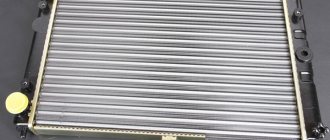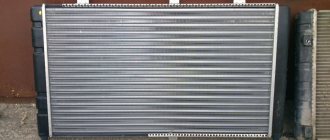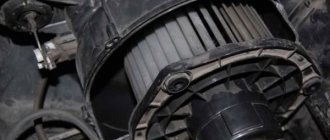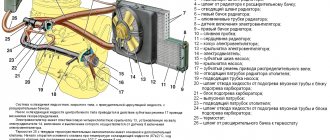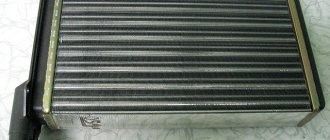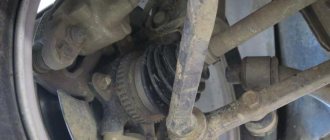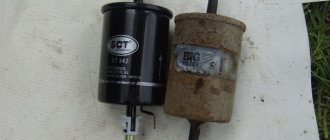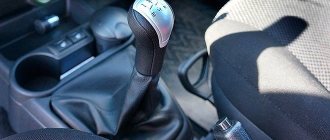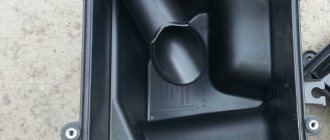| The engine cooling system (ECS) is one of the main systems of a car. Is cold air blowing from the stove or is the engine on the LADA Kalina overheating? Then the inspection should begin with this system. In this article you will find all the information on the operation of the Lada Kalina cooling system. |
Design features of the LADA Kalina engine cooling system
The LADA Kalina engine cooling system is liquid, closed type, with forced circulation. Consists of an engine cooling jacket, a radiator with an electric fan, a thermostat, a pump, an expansion tank and connecting hoses.
Design of the LADA Kalina cooling system
Cooling system : 1 — expansion tank; 2 — radiator outlet hose; 3 - inlet hose; 4 - radiator; 5 — steam exhaust hose; b — radiator supply hose; 7 — electric fan; 8 — electric fan casing; 9 — coolant temperature sensor; 10 — coolant temperature indicator sensor; 11 — throttle assembly; 12 — bracket for the coolant pump pipe; 13 — coolant pump; 14 — coolant pump pipe; 15 — heater radiator supply hose; 16 — heater radiator outlet hose; 17 — exhaust pipe; 18 — coolant pump pipe hose; 19 — thermostat housing
| Expansion tank . Coolant is poured into the system through the expansion tank. It is made of translucent polyethylene, which allows you to visually monitor the liquid level. To do this, the marks “MAX” and “MIN” are marked on the wall of the tank. In the upper part of the tank there is a pipe for connecting to the radiator steam exhaust hose, in the lower part there is a pipe for connecting to the inlet hose. |
| Expansion tank cap with valves . The tightness of the system is ensured by the inlet and outlet valves in the expansion tank cap. The exhaust valve maintains increased (compared to atmospheric) pressure in the system on a hot engine (due to this, the boiling point of the liquid becomes higher, steam losses are reduced). It begins to open at a pressure of at least 1.1 bar. The intake valve opens when the pressure drops to system relative to atmospheric pressure by 0.03-0.13 bar (on a cooling engine). |
| The coolant pump is a vane, centrifugal type, driven from the crankshaft pulley by a timing belt. The pump housing is aluminum. The roller rotates in a double-row bearing. The bearing is lubricated for its entire service life. The outer ring of the bearing is locked with a screw. A toothed pulley is pressed onto the front end of the roller, and an impeller is pressed onto the rear end. A thrust ring made of a graphite-containing composition is pressed to the end of the impeller, behind which there is an oil seal. The pump housing has a control hole to detect fluid leakage when the pump fails. It is recommended to replace the pump as an assembly. The redistribution of liquid flows is controlled by a thermostat. |
An important step is removing the knot
The cooling radiator and related components are unscrewed using the following tools:
- socket wrench 10;
- pliers with cylindrical thin ends;
- Phillips screwdriver;
- when carrying out work on Kalina with air conditioning, use a set of TOPEX internal socket wrenches (star-shaped).
To dismantle the radiator, you must first remove the engine cooling fan, having first disconnected the power connector from it. The fan is attached to the radiator with 4 bolts. The bolts are unscrewed with a 10 mm socket wrench, after which the fan is removed through the top.
The next step is to remove the rubber pipes from the radiator: upper, lower and coming from the expansion tank. The pipe clamps are loosened using pliers or a screwdriver. Next, use the same key to unscrew the 2 nuts securing the unit. The cooler can now be tilted towards the engine and pulled out.
When working with an air conditioned Kalina, you will have to deal with an additional cooling device attached to the main radiator. To separate them, you need to unscrew 4 bolts with a star key.
When removing the radiator, pay attention to the lower support pads; they can be removed along with the unit or remain in the body holes. It is better to remove the pillows to examine them for functionality. The same applies to rubber-metal bushings installed on the cooler body. If necessary, these parts must also be replaced.
A radiator malfunction can be localized by plugging its large pipes, immersing it in a container of water and supplying air at a pressure of no higher than 1 bar through a small fitting. If there are many places where air breaks through, then the unit is replaced with a new one.
If you have 1-2 small fistulas, try to negotiate a repair at a service station; you should not undertake this yourself. The design of the aluminum radiator is such that careless movements can easily cause even more damage.
The new cooler is installed together with the cushions in place and screwed with nuts. Further assembly is carried out in the reverse order, and attention should be paid to the condition of the rubber pipes and clamps. It might be better to replace them too.
The system is filled with antifreeze until it flows from the small pipe going to the throttle valve.
LADA Kalina engine cooling system diagram
Cooling system : 1 — coolant drain hose from the heater radiator; 2 — hose for supplying coolant to the heater radiator; 3 — coolant pump supply pipe hose; 4 — expansion tank hose; 5 - expansion tank; 6 — steam exhaust hose of the engine radiator; 7 — thermostat; 8 — hose for supplying fluid to the throttle assembly; 9 — hose for supplying fluid to the engine radiator; 10 hose for draining fluid from the engine radiator; 11 — engine radiator; 12 radiator drain plug; 13 electric radiator fan; 14 coolant pump; 15 supply pipe of the coolant pump; 16 coolant drain hose from the throttle body
Kalina cooling system
There are two circles of fluid circulation: large and small. With a large circle, the coolant passes through the engine cooling jacket and the radiator, and with a small circle, the radiator is not involved.
The heating system also includes a heater radiator and a throttle body heating unit. The liquid circulates in them regardless of the position of the thermostat damper.
To increase the boiling point of a liquid, the system must be completely sealed. Tightness is ensured by the inlet and outlet valve, which is located in the cap of the expansion tank. The exhaust valve maintains system pressure when the engine is hot and opens when the pressure exceeds 1.1 bar. The inlet valve opens when the pressure in the system decreases relative to atmospheric pressure by 0.03-0.13 bar.
That is why you should not open the cap of the expansion tank of the Lada Kalina cooling system when the engine is hot: you can get burned from the splashing jet of steam and coolant!
The thermal operating mode of the engine is maintained by a thermostat and an electric radiator fan, and is activated via a relay based on a sensor signal. To monitor the fluid temperature, a sensor is mounted in the engine cylinder head. Temperature information is displayed on the instrument panel from it. For the controller, the sensor is located in the pipe, next to the thermostat.
Cooling system Lada Kalina (click on the picture to enlarge it):
1 - expansion tank; 2 — radiator outlet hose; 3 - inlet hose; 4 - radiator; 5 — steam exhaust hose; 6 — radiator supply hose; 7 — electric fan; 8 — electric fan casing; 9 — coolant temperature sensor; 10 — coolant temperature indicator sensor; 11 — throttle assembly; 12 — bracket for the coolant pump pipe; 13 — coolant pump; 14 — coolant pump pipe; 15 — heater radiator supply hose; 16 — heater radiator outlet hose; 17 — exhaust pipe; 18 — coolant pump pipe hose; 19 — thermostat housing.
Are you doing your own repairs to your steel horse? Detailed instructions about the Lada Kalina fuse box: fuse diagram and typical faults.
And here is everything about tuning the Kalina engine in instructions and photographs. We recommend it to all lovers of alterations to their cars.
Cooling radiator
This part in Lada Kalina is used to cool antifreeze, which subsequently cools the engine block. The radiator itself is a rectangular piece; inside it there are many tubes with fins attached to them. Coolant flows through these tubes, and the oncoming flow cools it. At the entrance to the radiator there is hot coolant, and at the exit it is cold.
Why does it fail
Radiator failures on Kalina are associated with both external and internal factors. For example, quite often the radiator fails due to external damage, be it an accident, or impacts on snow and stones. Breakdowns also often occur due to low-quality antifreeze or antifreeze, which, under the influence of temperature, enters into a chemical reaction with plastic and aluminum, damaging the radiator.
Causes of radiator failure:
- Poor quality antifreeze;
- Mechanical damage;
- Increasing pressure in the system;
- Natural aging.
Another reason for a radiator breakdown is improper car repairs, which can damage the radiator. Many people, when changing a cooling fan or intake manifold, damage the radiator, after which it begins to leak.
Signs of a faulty radiator:
- Coolant drops under the front of the car;
- The radiator is covered in dust;
- There are traces of coolant on the radiator;
- The car engine is overheating.
If your car exhibits similar malfunctions, then most likely your cooling radiator is faulty.
Radiator leak repair
A leaking radiator can be repaired. There are specialists who replace radiator side tanks and also solder damaged areas, but, as a rule, such repairs are slightly cheaper than the cost of the radiator itself and do not fully guarantee that after heating the leak will not form again.
There are various additives that are added to the engine cooling system and then plug the crack, eliminating the leak from the inside. It is highly not recommended to use such things, since by eliminating a leak in the radiator, you can damage the engine, since the chemical used in such fluids can clog the cooling jacket of the cylinder block, which will lead to overheating of the engine.
Quite often, such additives damage the radiator of a car’s heater, since it uses small tubes that are easily clogged.
Replacing the cooling radiator
The process of replacing a cooling radiator is a rather labor-intensive process that involves disassembling the front part of the car. Below in the video you can study in detail the instructions for replacing the cooling radiator on the Lada Kalina.
Price
The price of a cooling radiator for Kalina starts from 4,000 rubles and can reach 10,000. It all depends on the manufacturer of the part, the store and the region of purchase.
Thermostat Lada Kalina
The thermostat serves as a kind of valve that regulates the movement of fluid.
Inside the thermostat there is a solid temperature-sensitive element and two valves that redistribute fluid flows. On a cold engine, the valve directs fluid only in a small circle. When the temperature reaches 85 ±2 °C, the main valve begins to open and coolant flows into the radiator, while the small circle is also open. At temperatures above 100 °C, the valve opens completely and the bypass valve closes.
How to eliminate airiness
When the radiator is removed and there is no coolant, the Kalina's cooling system can be modified. The fact is that in the VAZ-1118 it suffers from one unpleasant “disease” - airing and overheating, which is associated with a mistake by the car’s developers. Methods by which modernization is usually carried out:
- Replacing the thermostat. Instead of the standard one, which has 5 holes, a new element with 6 holes is installed.
- A coolant filter is added to the design.
- A faucet is installed on the Kalina stove.
The methods listed are not very effective, so experienced car enthusiasts use a more radical modification of the cooling system with the addition of a steam exhaust tube.
The scheme is as follows: a tee is cut into the pipe going to the expansion tank, which is connected with a separate hose to the fitting on the throttle valve block. The second tee is placed on the return line from the stove and is also connected to the expansion tank.
The procedure for replacing an engine cooling radiator is not particularly difficult and, if you have time, can be easily done with your own hands. What you cannot do yourself is to solder the aluminum honeycombs of the unit, and not every service station will undertake this.
tweet
back Selecting covers for Kalina
Next How to adjust the clutch on Kalina yourself
Tags: replacement, radiator, repair
Radiator Lada Kalina
The radiator on the Lada Kalina consists of two vertical plastic tanks and two horizontal rows of round aluminum tubes passing through the cooling plates. Next to the inlet pipe there is a thin pipe for the steam removal hose. The radiator has a casing with an electric fan. The liquid is supplied through the upper pipe and discharged through the lower. There is a drain plug at the bottom of the right tank.
Continue reading: DIY car protective polishing. Detailed instructions for polishing the body of your car!
And here is everything about car freezers: what types they are and which car freezer is better to choose.
Also, we have collected all the reviews from VAZ Kalina owners in a special section of the site. Find out what drivers who have driven Kalina for many years think about!

